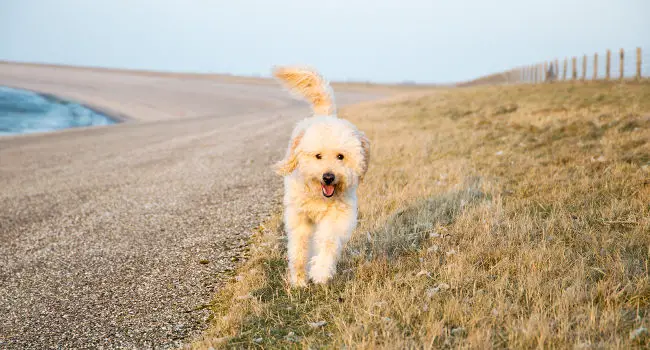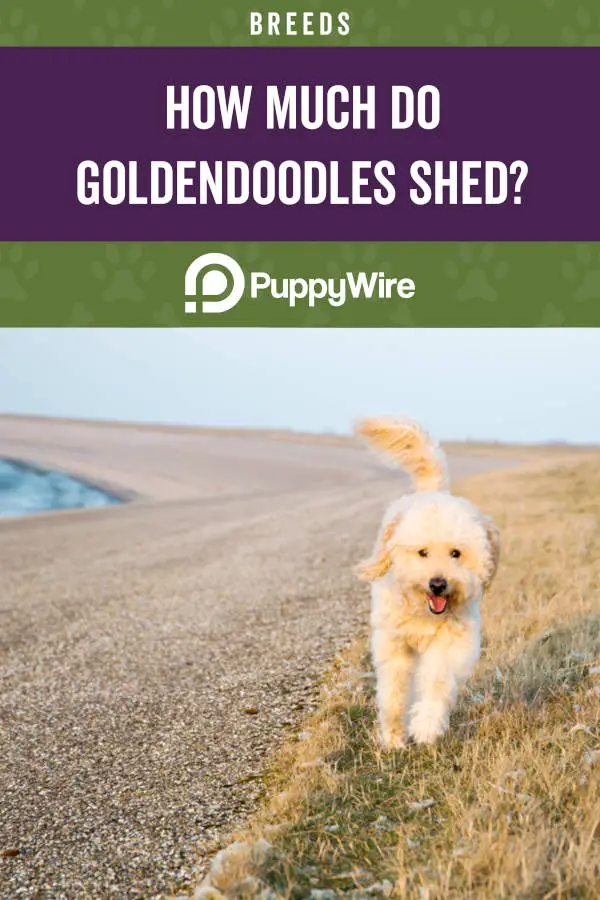Do Goldendoodles Shed?

With all of the hype about Goldendoodles, you may wonder, “Do Goldendoodles shed?” The short answer is yes they do because there is no such thing as a dog that doesn’t shed.
However, because this designer dog has such a unique coat, you can get a dog that barely sheds at all. This is where people get the idea that they don’t shed and they’re great for allergy sufferers. We’re going to break down the specifics with this dog’s coat below.
Decoding the Hypoallergenic Dog Myth
One selling point a lot of people use with Goldendoodles is by claiming that they’re a hypoallergenic dog breed. However, this isn’t true because there is no such thing as a completely hypoallergenic dog breed because all dogs have the protein that triggers allergies.
There is a protein in your dog’s saliva, urine, and pet dander called F 1, and every single dog has it. Coming into contact with the hair your dog sheds, urine when you clean up after them, or if they lick your hand is all enough to set off an allergic reaction.
Goldendoodles simply have less dander overall, and this makes them less likely to cause an allergic reaction. This is why many people choose them for family pets if someone has a sensitivity.
Finding Out How Much Your Goldendoodle Will Shed
There are two main categories when it comes to the chances of you getting a Goldendoodle that sheds a lot. We’ll make this easy to understand below.
F1 Goldendoodle
The F1 Goldendoodle is a first-generation mix of a purebred Golden Retriever and a purebred Standard Poodle. Golden Retrievers usually shed heavily, and Poodles usually shed very lightly. This means that your dog has a 50% chance of being a heavy shedder.
| Parent: Poodle Light Shedding (Pl) |
|
|---|---|
| Parent: Golden Retriever – Heavy Shedding (Gh) | PlGh |
Our table shows that your dog will have a 50% chance of heavy shedding with a 50% chance of light shedding. It’s likely that your dog will fall between the two extremes because genetics aren’t a sure thing. It’ll all depend on how your dog’s genetics express themselves as your dog grows.
F1b Goldendoodle
The second class is the F1b Goldendoodle, and this dog is a mix of a first-generation Goldendoodle and a purebred Poodle. This makes your dog 25% Golden Retriever and 75% Poodle, and it gives you dog a much better chance of only having light shedding.
| Parent: Poodle Light Shedding (Pl) |
|
|---|---|
| Parent: F1 Goldendoodle – Heavy Shedding (1h) | Pl1h |
| Parent: F1 Goldendoodle – Mid-Range Shedding (1m) | Pl1m |
| Parent: F1 Goldendoodle – Light Shedding (1l) | Pl1l |
So, if you were to breed an F1 Goldendoodle to a Poodle, the puppy has a 50% chance of shedding heavily, and this is the Pl1h category. If you breed a lighter shedding Goldendoodle with a lighter shedding Poodle, you’ll have a 100% chance of getting a puppy with light shedding, and this is Pl1l.
Finally, if you breed a Goldendoodle that falls between the two categories with a Poodle, you’ll get between a 50% and 100% chance of a puppy with light shedding. This is Pl1m, and the goal is to tip the odds in your favor of getting a puppy with very low shedding cycles.
Different Coat Types
Depending on their genetics, your dog has different coat criteria that will also influence how much they shed. You also have to consider their facial hair, and we’ve outlined this all below.
- Coat Length – The FGF5 is responsible for your dog’s coat length, and the first two generations are more prone to having shorter coats. The farther you get away from these generations, the more likely it is your dog will have a long coat.
- Coat Texture – Your dog can have a wavy, curly, or short coat, and the KRT71 gene is the deciding factor. If your puppy gets the KRT71 gene from both of their parents, they’ll end up with a curly coat texture.
- Facial Hair – The RSP02 gene dictates your puppy’s eyebrows, mustache, and their beard. This is a dominant gene, and your puppy only needs one copy from one parent to decide how their facial hair will be.
Related Post: Top 7 Dog Food Picks for Your Goldendoodle
Dealing with Shedding
No matter what type of coat your dog inherits, you’ll have to do a little work to keep both the coat and your dog’s skin healthy. They tend to shed their puppy coat into their adult coat between six and nine months, and they can also go through seasonal shedding. The best things you can do for your dog include:
- Brush Out Your Dog – Ideally, you want to take time and brush your dog out several times a week if you don’t do it for a few minutes each day. This will help remove some of the dead and dying coat, and it’ll allow your dog’s skin to get a good airflow to it to prevent rashes.
- Limit Outdoor Time – Since the Goldendoodle is an active dog, keeping them indoors around the clock may not make for a happy dog. But, having them go play outside the same time each day can give them routine sun exposure, and this can help even out their shedding.
- Keep Them Clipped – You may not have to take your dog to a groomer if they have the shorter coats. However, you do want to keep them free of mats, snarls, debris, and anything that could compromise the coat health. This requires routine grooming at home or at the groomers.
- Make a Shedding Calendar – Keep track of when your dog starts to shed each year. This will give you an idea when it’s coming up, and you can prepare accordingly to help your dog work through the shedding process.
Bottom Line
Do Goldendoodles shed? Now you know that they do, and you also know which generations are more prone to shedding and why. We also outlined exactly what you can do to help keep your dog and your family comfortable and keep the dog dandruff to a minimum.
